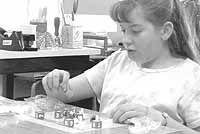| Jessica Bedwell sets up her own equation. |
“Numeracy is the ability to manipulate numbers, perform computation, reason mathematically, and to be fluent and confident when working with numbers,” according to Robin Hussey the district secondary math specialist. Achieving numeracy is as important in mathematics instruction as literacy is in language arts instruction. To be competent in this century, students need to achieve fluency in mathematics. Teachers throughout the district are working hard to achieve this goal with their own students and within their own grade levels. One of the best ways to reach the goal of numeracy is to use an approach known as hands-on math or manipulatives in mathematics.
The state goals are for learners to value mathematics, communicate mathematically, and reason mathematically. Further, learners will become confident in their ability to do mathematics and be mathematical problem solvers.
If you have not watched this process, you do not know what you are missing. “Kids are not afraid of math,” says Kathy Railsback, sixth grade math teacher at Wellington Elementary. “They are engaged in their learning when they use objects to understand concepts. They talk like mathematicians, now.”
Hands On Math
What is hands-on mathematics? It is a lot of things according to Jill Pappas, district elementary math specialist, but mostly it involves helping students learn abstract concepts with concrete objects. First a math concept is introduced to students using concrete objects such as dies, cubes, dominos, tangrams, or cards. Then, students advance to pictorial representations of the objects; they are asked to sketch their understanding of the concept. They also discuss, ask questions, answer questions, and write about the concept. Finally, they move to the abstract form of the concept.
Pappas says, “Using manipulatives to teach math may take longer at first, but long-term, children learn math faster. Using manipulatives correctly increases students understanding of math and accelerates retention. Students know why they are doing something. They no longer simply memorize rules; they must show why an operation is performed. Students discuss math differently than they used to talk about it. Students are forced to think mathematically, to show and explain their work and reasoning.”
Staff Development
Teachers are meeting in grade levels in elementary across the district. They are now grade level teams, not just a school’s grade level. They discuss their own students’ progress in terms of what their students mastered on core assessments as well as what concepts were weak. Teachers share their most successful practices and participate in inservice to strengthen challenging areas.
Teachers also discuss strategies for instructing students in heterogeneous groups. Traditionally, elementary teachers taught students in homogeneous or ability groups. Students were divided according to high, medium, and low groups within the grade level. Now, students stay with their teacher and are taught the same concept. They participate in cooperative learning groups versus traditional leveled groups. When instruction is aimed at a high level, the pace of learning is increased and accelerated. Children are not left behind because the instruction is tiered in terms of difficulty.
One advantage of heterogeneous grouping is that teachers can receive feedback from core assessments for their entire class. In the past, teachers did not necessarily instruct math to their homeroom class. Teachers can now more accurately self-assess their instruction.They are able to pace their instruction more accurately, monitor practice of concepts, and use new methods where needed.
| Elementary teachers from across the district align the core curriculum and their math textbooks. |
Staff development workshops focus on helping teachers use objects, manipulatives, and activities to teach math concepts. The literature connection is such an activity. Books that deal with concepts personalize the concept for the student. It engages them more forcefully with their learning.
How to use the textbook is another staff development topic. The textbook is a tool for teaching the core curriculum. The core dictates what to teach, and the text is one of the tools teachers use to reach the goal.
State and National Standards in Math
Carbon teachers are using a pacing guide developed by the Utah State Office of Education for the elementary level. The pacing guide is the recommended movement through the curriculum for the year in the K-12 Mathematics Standards. The math standards focus on both content and process. Content skills are number and operations, algebra, geometry, measurement, and data analysis/probability. Process skills are problem solving, reasoning/proof, communication, connections, representation. These standards reflect the standards of the National Council of Teachers of Mathematics, which are a national consensus of the concepts students should know in mathematics.
According to NCTM professional standards, as teachers shift toward the vision of teaching presented by the standards, one would expect teachers to be asking questions such as, “Why do you think that? Why is that true? How did you reach that conclusion? Can you make a model to show that? What assumptions are you making? Do you see a pattern? Can you predict the next one? How did you think about the problem?”
Try this
Here is an activity to increase your number sense and establish a literature connection.
How much is a million? David M. Schwartz, illustrated by Steven Kellogg, Lothrop, New York, 1985. Marvelosissimo the Mathematical Magician says that if one million kids stood on one another’s shoulders, they would be farther up than planes can fly. If you wanted to count to a million, it would take you about 23 days. How big would a gold fish bowl need to be to hold a million gold fish? If you started counting today, how long would it take you to count to a billion? The answers to these questions and a lot more are found in the back of the book where Marvelosissimo tells readers how he arrived at his answers. Hint, large numbers like 347,996,268 require at least 2 seconds to say. So, do the math.

